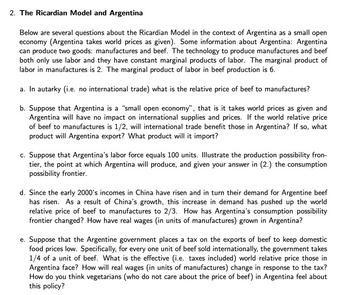
ENGR.ECONOMIC ANALYSIS
14th Edition
ISBN: 9780190931919
Author: NEWNAN
Publisher: Oxford University Press
expand_more
expand_more
format_list_bulleted
Question
solve a,b,c,d for me please. and explain too.

Transcribed Image Text:2. The Ricardian Model and Argentina
Below are several questions about the Ricardian Model in the context of Argentina as a small open
economy (Argentina takes world prices as given). Some information about Argentina: Argentina
can produce two goods: manufactures and beef. The technology to produce manufactures and beef
both only use labor and they have constant marginal products of labor. The marginal product of
labor in manufactures is 2. The marginal product of labor in beef production is 6.
a. In autarky (i.e. no international trade) what is the relative price of beef to manufactures?
b. Suppose that Argentina is a "small open economy", that is it takes world prices as given and
Argentina will have no impact on international supplies and prices. If the world relative price
of beef to manufactures is 1/2, will international trade benefit those in Argentina? If so, what
product will Argentina export? What product will it import?
c. Suppose that Argentina's labor force equals 100 units. Illustrate the production possibility fron-
tier, the point at which Argentina will produce, and given your answer in (2.) the consumption
possibility frontier.
d. Since the early 2000's incomes in China have risen and in turn their demand for Argentine beef
has risen. As a result of China's growth, this increase in demand has pushed up the world
relative price of beef to manufactures to 2/3. How has Argentina's consumption possibility
frontier changed? How have real wages (in units of manufactures) grown in Argentina?
e. Suppose that the Argentine government places a tax on the exports of beef to keep domestic
food prices low. Specifically, for every one unit of beef sold internationally, the government takes
1/4 of a unit of beef. What is the effective (i.e. taxes included) world relative price those in
Argentina face? How will real wages (in units of manufactures) change in response to the tax?
How do you think vegetarians (who do not care about the price of beef) in Argentina feel about
this policy?
Expert Solution
This question has been solved!
Explore an expertly crafted, step-by-step solution for a thorough understanding of key concepts.
Step by stepSolved in 1 steps

Knowledge Booster
Similar questions
arrow_back_ios
arrow_forward_ios
Recommended textbooks for you

 Principles of Economics (12th Edition)EconomicsISBN:9780134078779Author:Karl E. Case, Ray C. Fair, Sharon E. OsterPublisher:PEARSON
Principles of Economics (12th Edition)EconomicsISBN:9780134078779Author:Karl E. Case, Ray C. Fair, Sharon E. OsterPublisher:PEARSON Engineering Economy (17th Edition)EconomicsISBN:9780134870069Author:William G. Sullivan, Elin M. Wicks, C. Patrick KoellingPublisher:PEARSON
Engineering Economy (17th Edition)EconomicsISBN:9780134870069Author:William G. Sullivan, Elin M. Wicks, C. Patrick KoellingPublisher:PEARSON Principles of Economics (MindTap Course List)EconomicsISBN:9781305585126Author:N. Gregory MankiwPublisher:Cengage Learning
Principles of Economics (MindTap Course List)EconomicsISBN:9781305585126Author:N. Gregory MankiwPublisher:Cengage Learning Managerial Economics: A Problem Solving ApproachEconomicsISBN:9781337106665Author:Luke M. Froeb, Brian T. McCann, Michael R. Ward, Mike ShorPublisher:Cengage Learning
Managerial Economics: A Problem Solving ApproachEconomicsISBN:9781337106665Author:Luke M. Froeb, Brian T. McCann, Michael R. Ward, Mike ShorPublisher:Cengage Learning Managerial Economics & Business Strategy (Mcgraw-...EconomicsISBN:9781259290619Author:Michael Baye, Jeff PrincePublisher:McGraw-Hill Education
Managerial Economics & Business Strategy (Mcgraw-...EconomicsISBN:9781259290619Author:Michael Baye, Jeff PrincePublisher:McGraw-Hill Education


Principles of Economics (12th Edition)
Economics
ISBN:9780134078779
Author:Karl E. Case, Ray C. Fair, Sharon E. Oster
Publisher:PEARSON

Engineering Economy (17th Edition)
Economics
ISBN:9780134870069
Author:William G. Sullivan, Elin M. Wicks, C. Patrick Koelling
Publisher:PEARSON

Principles of Economics (MindTap Course List)
Economics
ISBN:9781305585126
Author:N. Gregory Mankiw
Publisher:Cengage Learning

Managerial Economics: A Problem Solving Approach
Economics
ISBN:9781337106665
Author:Luke M. Froeb, Brian T. McCann, Michael R. Ward, Mike Shor
Publisher:Cengage Learning

Managerial Economics & Business Strategy (Mcgraw-...
Economics
ISBN:9781259290619
Author:Michael Baye, Jeff Prince
Publisher:McGraw-Hill Education